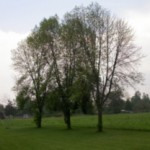Managing Trees Under Stress
Suggested Care of Trees Showing Signs of Stress:
- Good growing conditions, and appropriate care to minimize stress, will enable many trees showing signs of stress to recover and return to good health.
- Many trees have the capacity to recover from stress. Allow trees showing injury symptoms to remain in the ground during the fall and winter to fully assess the potential for recovery the following spring.
According to a Bartlett Tree technical report on remedial treatment practices:- Irrigating the plant during dry periods will minimize moisture stress.
- Tree fertilization should be avoided for a minimum of one growing season because stimulating excess growth can compound injury from certain herbicides.
- Pruning should be delayed for at least a year to fully assess the extent of injury.
- Do not over irrigate. One good soaking per week if there has been no rain.
- Deep root fertilization of trees should be avoided until trees recover.
- Immediate pruning is necessary if dead branches pose a danger to life or property.
- Please consult L.C.S. Lawn and Tree Service, Inc.’s certified Arborist, if you have any questions regarding particular care of your trees.
Replacing Trees:
- Summer is not a good time to plant a tree. The temperature is too hot and the actively growing plants are susceptible to damage from stress due to replanting.
- The best time to plant a tree is in the fall or early spring (October to April) when tree growth is dormant and temperatures are cooler.
Disposal of Trees:
- Trees that are cut down may be used for lumber or for use as firewood.
- If allowed by local yard waste regulation, trees may be disposed of in the trash.
- If allowed by local regulations burning is an alternative method of disposal.

